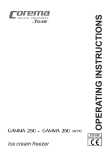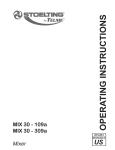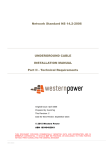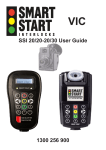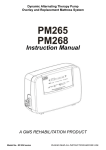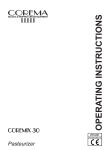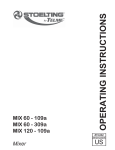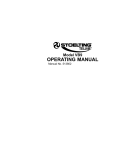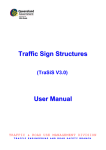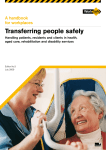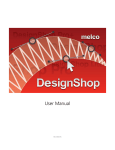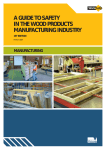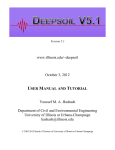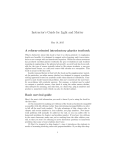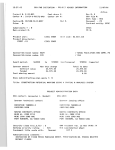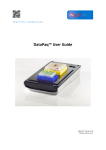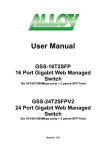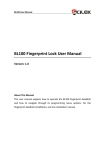Download TraSiCAD 2.8 user manual - Department of Transport and Main Roads
Transcript
15th October 2008 TraSiCAD v 2.8 Instruction Manual Contact Information Name:Tom Vucetic Address :- 477 Boundary St. Spring Hill Brisbane 4001 Phone:07 38347315 Fax:07 38342201 Email:- [email protected] TraSiCAD 2.8 – October 2008 2 CHAPTER 1 CONTENTS INTRODUCTION TO THE MANUAL SECTION 1 1.1 CHAPTER 2 ABOUT THIS USER MANUAL Purpose of this manual USING TRASICAD …………………. 5 …………………. 6 …………………. 6 …………………. 7 SECTION 2.1 What is TraSiCAD ? …………………. 8 SECTION 2.2 INSTALLING TraSiCAD …………………. 9 SECTION 2.3 OPENING TraSiCAD …………………. 10 SECTION 2.4 2.4.1 2.4.1.1 2.4.1.2 2.4.1.3 2.4.1.4 SETTING UP DEFAULTS AND OPTIONS Options General Edit New signs Display …………………. …………………. …………………. …………………. …………………. …………………. 10 10 10 11 11 11 SECTION 2.5 2.5.1 2.5.2 2.5.3 2.5.4 STARTING A DRAWING New Open Use Wizard History Bar …………………. …………………. …………………. …………………. …………………. 12 12 12 13 13 SECTION 2.6 2.6.1 2.6.1.1 2.6.1.2 2.6.1.3 2.6.1.4 2.6.1.5 2.6.1.6 2.6.1.7 2.6.1.8 2.6.1.9 2.6.1.10 2.6.2 2.6.3 2.6.4 2.6.5 2.6.6 2.6.7 2.6.8 2.6.9 DRAWING OPTIONS Functions Undo Redo Add Align Adjust Copy Cut Paste Paste special Delete Adding a Legend Adding a Road Name Patch Adding a Route Marker Adding an Other Sub-Sign Adding an image Adding an Arrow Adding a Roundabout Symbol Adding a Diagrammatic Direction Symbol …………………. …………………. …………………. …………………. …………………. …………………. …………………. …………………. …………………. …………………. …………………. …………………. …………………. …………………. …………………. …………………. …………………. …………………. …………………. …………………. 14 14 14 14 14 15 16 17 17 17 17 17 18 18 19 19 20 21 22 24 TraSiCAD 2.8 – October 2008 3 CONTENTS cont. SECTION SECTION SECTION 2.7 VIEWING OPTIONS …………………. 26 2.7.1 2.7.2 2.7.2.1 2.7.2.2 2.7.3 2.7.4 2.7.4.1 2.7.4.2 2.7.4.3 2.7.4.4 2.7.4.5 2.7.4.6 Zoom Gridlines Setup Show Grid Snap to Grid Dimensions Sign Properties Panels tab Legends tab Images tab Guide Symbols tab Signs & Sub- Signs tab Multi Panel Border and Colour control …………………. …………………. …………………. …………………. …………………. …………………. …………………. …………………. …………………. …………………. …………………. …………………. 26 26 27 27 27 28 28 29 29 29 30 31 2.8 SAVING A DRAWING …………………. 33 2.8.1 2.8.2 2.8.3 Save As Save Export …………………. …………………. …………………. 33 33 33 2.9 PRINTING …………………. 34 2.9.1 2.9.2 2.9.2.1 2.9.2.2 2.9.2.2 2.9.3 2.9.4 2.9.5 2.9.5.1 2.9.5.2 2.9.5.3 2.10 Printer Setup Page Setup Layout tab Title Block tab Margins tab Print Preview Print Sign Object Viewer Create List Save as Text Print List Closing a Drawing …………………. …………………. …………………. …………………. …………………. …………………. …………………. …………………. …………………. …………………. …………………. …………………. 34 34 34 35 35 36 37 37 37 37 37 38 General warning Licensing Details Extension of License Transfer of License …………………. …………………. …………………. …………………. …………………. 39 40 40 41 41 Sample Sign G1-4 drawing print out (no dimensions) Sample Sign G1-4 drawing print out (dimensions) G1-4 Route marker print out G1-4 Road Name Plate print out G1-4 Arrow symbols print out Order Form …………………. …………………. …………………. …………………. …………………. …………………. …………………. 42 43 44 45 46 47 48 CHAPTER 3 LICENSING 3.0 3.1 3.2 3.3 Appendix A TraSiCAD 2.8 – October 2008 4 CHAPTER 1 INTRODUCTION TO THE MANUAL TraSiCAD 2.8 – October 2008 5 Section 1 About This User Manual 1.1 The Purpose of this Manual Audience This User Manual is intended for designers utilising the TraSiCAD software program for the design of signs. Scope The User Manual describes the process involved to • Create new signs with in Standard guidelines • Produce designs for manufacture • Interpret messages, warnings and errors Reader Skills The User Manual assumes that the reader has a basic knowledge of: • • Personal computers Australian Standards relating to Road sign Specifications (AS1743) Expected Outcomes After studying this manual, the reader should be able to • Create new signs • Understand sign clearances • Print drawings • Interpret messages, warnings and errors TraSiCAD 2.8 – October 2008 6 CHAPTER 2 USING TRASICAD TraSiCAD 2.8 – October 2008 7 Section 2 2.1 WHAT IS TRASICAD ? TraSiCAD V2.8 is a program developed by Traffic Engineering and Road Safety Branch, a division of Main Roads to assist in the design of road signs. This user manual is intended to be used in conjunction with:Australian Standards AS 1743 Road signs – Specifications Australian Standard AS1744 Standard Alphabet for road signs Australian Standard AS1742 Local Area Traffic Management Manual of Uniform Traffic Control Devices (MUTCD) More information can be found on the Queensland Main Roads Department web site at www.mainroads.qld.gov.au For TraSiCAD V2.8 downloads search on "TRASICAD" TraSiCAD 2.8 – October 2008 8 2.2 INSTALLING TraSiCAD • BY CD Insert the TraSiCAD installation CD. Select Run on the Windows desktop Browse the CD drive Select Install TraSiCAD V2.8 TraSiCAD will automatically set up all files. Follow all prompts till completed, then select Finish • BY DOWNLOAD FILE Go to Main Roads web site (www.mainroads.qld.gov.au) • In the search bar search for TRASICAD. Find the relevant download • Save to a relevant PC directory • Select and run the Install file TraSiCAD will automatically set up all files. Follow all prompts till completed, then select Finish TraSiCAD 2.8 – October 2008 9 2.3 OPENING TraSiCAD After installation has been completed, open the program by either:1. Running from the executable file in the directory in which the program was installed. or 2. Double click on the TraSiCAD icon developed on the computer desktop during the installation. The TraSiCAD working screen will appear showing options directories to be used in TraSiCAD design. Note TraSiCAD has its own complete Help function that may be utilised in conjunction with this user manual. 2.4 SETTING UP DEFAULTS AND OPTIONS TraSiCAD can set various default options required during the drawing design process. Before using TraSiCAD the various options can be set up with default characteristics. For faster and more efficient use of the program these options should be set prior to the commencement of any design. 2.4.1 Options From the Tools directory select Options. This opens a dialogue box with 4 tab functions. 2.4.1.1 General • Gives the option of selecting parameters with particular RTA characteristics. • Accesses the clearance Rule Set that determines the particular clearance rules for the elements within the sign. A new rule set* is determined at Supervisor level by a separate Rule Generator. • Sets the order in which clearances are made. • Allows automatic setting of Borders and corner radii when clearing, if required. • Redirects the default sign saving directory to user defined, if required. * These Rule sets have been based on the AS 1743 standards and should not be modified unless there are valid design reasons. Because they are permanently editable, care should be taken in any modification process. It is advised to keep a Master copy of these rules or create a new working Rule set through the New option. TraSiCAD 2.8 – October 2008 10 2.4.1.2 Edit • Varies the nudge distance of elements on the sign face. Using the UP/DOWN/LEFT/RIGHT arrows on the keyboard, fine control of element placement can be achieved. • Allows selection of copying file types • Selects the number of Undo functions available. • Can decide if the undo / redo stack is reset or not after a save function has been completed. (1) Default legend 2.4.1.3 New Signs • Sets the Default Legend height. This height sets clearances in association with the current rule set being used. • Enables the setting of default legend for the various signs and route markers, which are utilised in conjunction with the various wizards. TO BE COMPLETED PRIOR TO USE OF TraSiCAD. • • • • • • (2) Default Print Settings Selects ability to show arrow heads in dimensions Selects the default printing scales. Sets the default print margins. Sets the default font for the print title block. (3) Default Title Block Settings Sets default Business Unit Details Loads/deletes a pre designed logo as a default for use in the print title block. 2.4.1.4 Display Sets the colouring characteristics of TraSiCad when non-system colours are displayed and represented. When using a display device with a colour palette smaller than 24 bits, some colours will not be available in the device palette and will need to be approximated. Two methods are available: • Closest Match - Colours are represented by the closest matching colour from the logical palette of the display device. • Dithering - Colours are represented by drawing a pattern using similar colours. TraSiCAD 2.8 – October 2008 11 2.5 STARTING A DRAWING There are 4 different methods of accessing drawings within the TraSiCAD program. Selecting the File directory indicates New, Open, Wizard or the file history bar. Note:- Once a drawing has been commenced, it is recommended that the Sign Properties Feature (Alt+P) is utilised to enable user nominated variables to be entered. (see 2.7.4) 2.5.1 New - Used to develop new signs utilising basic styles and backgrounds. There are up to 16 different styles that are selectable from this box. 2.5.2 Open –Used to open a previously designed sign from a file directory. This option can be used to modify, copy or print previously designed signs selected from the user’s specific local or network files and directories. (see 2.4.1.1) or Can be used to access the specific Signs directory within TraSiCAD. This directory contains a number of signs. TraSiCAD 2.8 – October 2008 12 2.5.3 Use Wizard - Used to select a particular type of sign from a list of wizards (RTA selection if needed. See 2.4.1.1). This gives a specific design of a sign which will be set out according to predetermined standard format and style. Wizard selection process • RTA selection Main Roads selection Select required Wizard (Dependant on which installation is used (RTA or MR) an example window indicates the type of sign to be selected.) • Select number of panels (if available) the particular Legend Type and Height. Note:- The legend value selected here only assigns the characteristics for the legends on that sign. They have NO bearing on the Default legend height value that set the clearance values between the elements on that sign. • For each of the panels requested in the previous step, select and apply details for a Road Name Patch, Route Marker type and number, Arrow type and Legend Note :- To assist with drawing efficiency, the subsequent use of any wizard allows the user to utilise previously entered values of a wizard when it was last run. For example if a three panelled wizard design was initially utilised and there was a requirement for a subsequent two panelled sign, then any of the legends or symbols from the first two panels may be selected for use in that new design 2.5.4 History Bar - Used to select up to ten previously worked on drawings with out the need to close off the current drawing. TraSiCAD 2.8 – October 2008 13 2.6 2.6.1 DRAWING OPTIONS Functions Modifications, additions and adjustments can be made to any sign drawing utilising the Edit directory on the tool bar. The functions dialogue box gives access to options which include :• Undo • Redo • Add • Align • Adjust • Copy • Cut • Paste • Paste Special • Delete Selection from this list in the Edit directory or using the associated short cut keys will utilise the functions as follows:- 2.6.1.1 Undo Undoes the last number of drawing steps carried out. (Undo levels are set in Tools directory under Options / Edit.) (see 2.4.1.2) 2.6.1.2 Redo Redoes the previous Undo functions. Redo’s are limited by the amount of undo levels. 2.6.1.3 Add Facilitates the addition of various items to be inserted in a drawing. Consisting of :• Legends • Road Name patches, • Route markers • Sub Signs • Images from file (see 2.6.2) • Arrows (see 2.6.3) • Roundabout signs (see 2.6.4) and • Diagrammatic Direction Symbols (see 2.6.5). TraSiCAD 2.8 – October 2008 14 2.6.1.4 Align This function allows for the horizontal or vertical alignment of two or more separate items on a drawing. Note:- All preselected items will aligned to the LAST item selected in the Align process. Alignment of two single items 1. Select the first item requiring to be aligned to a another. 2. Hold down the shift key and select the second item. 3. Select Edit directory then Align (or Ctrl L). An Alignment Tool dialogue box will appear. 4. Select the relevant Horizontal (Top, Centre or Bottom) or Vertical (Left, Centre or Right) alignment box. 5. The items will appear aligned on the screen. 6. Select OK. 7. The sign will be permanently aligned and updated in the drawing. Vertical alignment of multiple legends (eg.Rest Area & 1km) Quantity items may be made up of two separate “words” (eg. “1” &” km”). To correctly align these separated quantity items with other legends :1. Select the number “1” 2. Hold the shift key then select “km” 3. While still holding the shift key select the legend “Rest Area” to which the quantity item is to be aligned. 4. Select Edit directory then Align (Ctrl L) where an Alignment Tool dialogue box will appear. 5. Select the Group Into Rows box. TraSiCAD 2.8 – October 2008 15 This will group select the “1” and the “km.” This will be indicated on the screen with dotted box enclosing both items selected. 6. Select Centre for a centre alignment. A position measurement indicator will appear signifying the centre position of the new alignment line. Manual modifications to this position measurement can be made in this box if required by direct editing or using the up / down arrows. 7. Select OK to generate the newly aligned sign. 2.6.1.5 • Adjust Sets the automatic adjustment of items on the sign face at predetermined clearances. Two separate options are available. Apply Clearance Rules Enforces an automatic clearance on all items on the drawing to give predetermined spacings from rules installed within TraSiCAD. These rules can be found in the Rule Editor in the Options directory. (see 2.4.1.1 SETTING UP DEFAULTS AND OPTIONS ). Note:Note: Clearances are determined by the “Default legend” size and not Clearances are determined by the “Default legend” size the which may size of the legend being utilised on the drawing. NOT be the size of the legend being utilised on the drawing. TraSiCAD 2.8 – October 2008 16 • Reduce Sign This option completely reduces the sign to its smallest size, taking into consideration and applying clearance rules formulated in the Rule Sets previously mentioned in 2.4.1.1. It will set the borders and corner radii to the appropriate values if the particular request boxes are checked in the Options / General dialogue box.(2.4.1.1.) 2.6.1.6 Copy Takes a copy of the selected item on the drawing and places it on a working clipboard to be reutilised on that drawing or in other compatible software applications. The copied item remains intact on the drawing. 2.6.1.7 Cut Takes a copy of the selected item before erasing it from the drawing. It places it on a working clipboard to be reutilised on that drawing or in other compatible software applications. This function can also be used as a delete. Note that the working clipboard will only hold one item at a time. If another object is subsequently cut or copied the previous object will me overwritten, depending on the number of undo levels. 2.6.1.8 Paste Places the object obtained by the last Cut or Copy function, from the working clipboard onto the present working drawing. 2.6.1.9 Paste Special Enables two separate ways to import items from the Clipboard of other Windows applications. • Paste Text as a Legend Takes text copied or cut to the “Clipboard” from other compatible applications and places it on the working drawing in a "Text Editable" format. • Paste Metafile as Image Imports an object or text copied or cut to the “Clipboard” from other compatible applications and places it on the working drawing in a NON editable form. This is ideal for quickly importing logos and symbols from electronic brochures. 2.6.1.10 Delete Deletes any object from the drawing. The option does not utilise the working clipboard and therefore the object will be deleted permanently. The Undo function will undelete any object deleted dependant on the amount of undo levels set in the Options \ Edit box (see 2.4.1.2) TraSiCAD 2.8 – October 2008 17 2.6.2 Adding a Legend Note. The Add function can be activated in a shortcut mode by placing the cursor somewhere on the active drawing and right clicking the mouse. A dialogue box with four options, including Add, will appear on the drawing. Selecting legend allows specified words to be imported into the drawing from the ensuing “Add to Panel” dialogue box. Particular Legend types and heights can be selected as required. Note that all fonts used in TraSiCAD are derived from the C:\Windows\Fonts directory. All Australian Standard Highway fonts (sold separately to this software) should be installed there. 2.6.3 Adding a Road Name Patch Note. The Add function can be activated in a shortcut mode by placing the cursor somewhere on the active drawing and right clicking the mouse. A dialogue box with four options, including Add, will appear on the drawing. Selecting Road Name Patch allows one of the following a specified shaped patches to be imported into the drawing from the ensuing “Add to Panel” dialogue box. • • • • Not Pointed Left Pointed Right Pointed Double pointed TraSiCAD 2.8 – October 2008 Note that the legend height used in a Road Name patch is automatically reduced to 75% of the main sign legend height. 18 2.6.4 Adding a Route marker Note. The Add function can be activated in a shortcut mode by placing the cursor somewhere on the active drawing and right clicking the mouse. A dialogue box with four options, including Add, will appear on the drawing Selecting Route Marker allows one of six different types of markers to be imported into the drawing from the ensuing “Add to Panel” dialogue box. • • • • • • 2.6.5 Alpha-numeric Route markers Tourist Route markers State Route markers Metroad Route markers National Highway Route markers National Route markers Adding an Other Sub- Sign Note. The Add function can be activated in a shortcut mode by placing the cursor somewhere on the active drawing and right clicking the mouse. A dialogue box with four options, including Add, will appear on the drawing Selecting Other Sub-sign allows selection of all types of signs to be imported onto the main sign from the ensuing “Add to Panel” dialogue box. TraSiCAD 2.8 – October 2008 19 2.6.6 Adding an Image Note. The Add function can be activated in a shortcut mode by placing the cursor somewhere on the active drawing and right clicking the mouse. A dialogue box with four options, including Add, will appear on the drawing. Selecting Image From File allows special image files to be imported into the drawing from the ensuing “Add to Panel” dialogue box. TraSiCAD has access to an internal directory of .wmf symbol files that can be directly imported into the drawing. Selecting add an Image From File will usually directly access the Symbols library within the TraSiCAD program. In a typical install this file location will be C:\Program files\MainRoads\TraSicad\Symbols Note: TraSiCAD allows the importation of any .emf or .wmf files. If other self generated symbols files are designed they may be placed in this directory for convenience or located in other directory locations to be “browsed” for. Select the required symbol. Select Open An “Add Image” dialogue box will appear indicating the symbol selected. The height and width are shown along with a scaling option to increase or reduce the importing size. Options can then be made to accept, change (reverts to previous dialogue box for another selection) or cancelling the symbol. TraSiCAD 2.8 – October 2008 20 2.6.7 Adding an Arrow symbol Note. The Add function can be activated in a shortcut mode by placing the cursor somewhere on the active drawing and right clicking the mouse. A dialogue box with four options, including Add, will appear on the drawing. Various types and sizes of arrows can be added to a sign by selection of the Arrow Symbol from the “Add to Panel” dialogue box. Various types and sizes of arrows can be designed and modified from the “Add New Arrow Symbol” dialogue box. Through various individual boxes the actual size of the arrow based on a particular legend height can be established along with, • • • • • • • • Widths, Lengths, Shaft lengths, Base widths, Arrow head heights, Arrow indents, Corner radius and Rotation angles Other functions to determine colours, rounded or pointed arrowheads and standardised long or short length shafts can be made in this option. Note: Double clicking on any colour brings up a full colour pallet A zoom function is also available to enhance the details in the design box. Note: this does not affect the zoom in the actual drawing TraSiCAD 2.8 – October 2008 21 2.6.8 Adding a Roundabout Symbol Note. The Add function can be activated in a shortcut mode by placing the cursor somewhere on the active drawing and right clicking the mouse. A dialogue box with four options, including Add, will appear on the drawing Various types and sizes of roundabouts can be added to a sign by selection of the Roundabout Symbol from the "Add to Panel" dialogue box. Various types and sizes of Roundabouts can be designed in the ensuing “Add New Roundabout” dialogue box. Three sections are can be accessed through various boxes in each, where a number of options for specific designs can be entered. • View section r1 Inner roundabout radius r2 Outer roundabout radius, a Views, sets and changes the value, in mm, of the height of the triangular tip of the exit leg. c Width of the exit legs. g Location in degrees of the gap. h Width of the arc gap in degrees. Roundabout colour Sets the symbol colour. Note: Double clicking on any colour brings up a full colour pallet Legend height Sets the overall size of the symbol Arc Gap Style Sets a Square ended exit, a Pointed end on the exit or a Double Point that gives a pointed entry and exit. Rotation Angle Sets the rotation angle (in degrees) of the symbol. Zoom Sets screen viewing for better design detail. TraSiCAD 2.8 – October 2008 22 • Exit Legs Section Exit legs may be straight or curved. By checking the Curved box, two options become available. Curved left and Attached at Base Sets the exits to curve clockwise as opposed to the default anticlockwise. Determines if the arc of a curved leg should be tangential to the roundabout body or tangential to centreline of the triangular tip of that leg. Other options:Leg Length New Exit Leg • • • Determines the radial distance in millimetres, from the roundabout outer edge to the base of the Exit leg’s triangular tip. Inserts extra legs and indicates them in the associated list box. Selection of a particular leg in the list box enables the user to: Modified parts of exit legs. Delete or Add a selected leg. Automatic size an exit leg via the Automatic Dimensioning Leg option. If the Automatic Dimensioning Leg box is not checked when an exit leg is selected, the leg can be “manually” sized via the Leg Details box. This separate dialogue box individually tailors the characteristics of that particular exit leg. • Entry Leg Section Entry legs may be straight or curved. By checking the Curved box, two options are made available. Curved left Sets the exits to curve clockwise as opposed to the default anticlockwise. Attached at Base Determines if the arc of a curved leg should be tangential to the roundabout body or tangential to centreline of the triangular tip of that leg. Leg Length modification can also be achieved in this section. TraSiCAD 2.8 – October 2008 23 2.6.9 Adding a Diagrammatic Direction Symbol Note. The Add function can be activated in a shortcut mode by placing the cursor somewhere on the active drawing and right clicking the mouse. A dialogue box with four options, including Add, will appear on the drawing Various types and sizes of Direction Symbols can be added to a sign by selection of the Diagrammatic Direction Symbol from the “Add to Panel” dialogue box. Various types and sizes of Diagrammatic Direction Symbols can be designed in the created “Add New Diagrammatic Direction Symbol” dialogue box. When utilising Diagrammatic Direction Symbols, three processes areas are used to assist the design. • Select, add and modify various branches to make up the basic design. • Select and modify curved or straight segments that when added together, make up a branch. • Actively viewing the design. • View section Zoom This assists in design view. It has no effect on the size of the diagram in the drawing Rotation Angle This rotates the diagram as required. Legend Height This determines the size of the diagram on the drawing Symbol Colour This sets the symbol colour. Note: Double clicking on any colour brings up a full colour pallet • Branch Segment Section Initial opening branch is tagged a Base Branch. This is in fact a pointed segment. As subsequent segments are added (straight or curved) they are nominated a sequential number. The latest segment is allocated the “Segment S1” notation (this notation increases as another segment is added) TraSiCAD 2.8 – October 2008 24 Selecting a particular segment in Base Branch Segments area activates modifiers that enable Headings, Lengths Widths Radius and Sweep to be altered as required. Add or remove segments by using the Add Line Segment/ Curve Segment or Delete Segment options. Curved Left option allows a default right curve to be changed to left if required. Note: every required left curve segment must be selected each time. • Branch Sections Once the main base branch has been designed it may be necessary to “overlay” another branch in the design. Selecting the Add Branch button produces another branch superimposed on the base branch. This is signified by Branch 1 in the “Branches” box. The Branch 1 Segment box now indicates another S1 segment. This S1 segment although shown in the box actually sits on the base branch and appears invisible. Only adding other sections shows its existence. When a new branch segment is selected The Edit branch area gives two other options:Heading. Off set This sets the direction to which the segment points This sets the amount of offset or distance the segment is set vertically up the branch As many new branches can be added as required to make up a detailed represented drawing. TraSiCAD 2.8 – October 2008 25 2.7 VIEWING OPTIONS During the drawing process TraSiCAD utilises various viewing options to assist accurate sign design. These options can be found in the View directory and consist of the four options :• Zoom • Gridlines Setup • Dimensions • Sign Properties 2.7.1 Zoom This feature scales the drawing up or down on the screen to assist the detailed designing of a sign. Zoom levels range from 50% to 1000% A Custom zoom range is also available and can be used to suit individualised viewing needs. 2.7.2 Gridlines Setup Enables a series of gridlines to be added to the drawing. This assists the particular spacing of items as each item is placed on the drawing. Any nominated grid size intervals up to a maximum of 1000 millimetres can be utilised. TraSiCAD 2.8 – October 2008 26 2.7.2.1 Show Grid When selected, this option enables the previously set grid to be visible on the screen for the drawing process. 2.7.2.2 Snap to Grid When checked this enables the items to be placed and “snapped” onto the drawing along the previously determined grid pattern. “Snapping” will occur whether or not the grid is visible. 2.7.3 Dimension Selecting this feature gives an exact indication of the lengths, heights and clearances of legends \ symbols on a drawing. See 2.9.2.1 for details on removing arrow heads for clearer detail In this mode there are two separate areas on the screen drawing that show, (a) All horizontal and vertical dimensions associated with any items on that drawing. (b) A tabled view of all font legends, font types and sizes being used on all the panels and sub signs within that drawing. Note: These dimensions actively vary as any drawing changes are being made. TraSiCAD 2.8 – October 2008 27 2.7.4 Sign Properties This feature enables the user to select and accurately modify colours and values of panels, plates, legends and elements associated within a particular sign. Note. Properties can be activated by either “Alt P” or placing the cursor somewhere on the active drawing and right clicking the mouse. A dialogue box with four options will appear. Select Sign Properties for that dialogue box. Example This dialogue box views five separate tabs that give access to particular variables in the sign. • Panels • Legends • Signs & Sub- Signs • Images • Guide Symbols 2.7.4.1 Panels tab Selecting a panel on the sign enables:• • • • • • accurate positioning within the sign, sizing to particular dimensions, splitting a panel horizontally or vertically colouring panels from the inherent panel colour (determined in Sign & Sub-signs tab) or from a colour pallet setting of border colours individually setting and colouring of all borders if a panel is split TraSiCAD 2.8 – October 2008 28 2.7.4.2 Legend tab Selection of this tab once a panel has been selected enables the legend type to be:• Accurately positioned within the panel • Viewed • Height and Type to be modified • Quickly sized to desired height • Automatic calculation of word width • Coloured from a colour pallet • Deleted if required 2.7.4.3 Images tab Allows the selected image on a particular panel to be:• Accurately positioned within the panel, • Identified • Sized to desired height or width, • Stretched (sized un proportionally) • Deleted if required. 2.7.4.4 Guide Symbol tab Selection of this tab enables the symbol widths and heights to be viewed as well as:• Accurately positioned within the panel, • Rotated, • Identified and / or renamed, • Sized according to legend height, • Direct Colour changed in pallet of colours, • Deleted, • Modified via the “Symbol Details” Note: Double clicking on any colour in the Edit Arrow Symbols Detail box brings up a full colour pallet TraSiCAD 2.8 – October 2008 29 2.7.4.5 Signs & Sub-signs tab Selection of this tab gives an overview of all the panels in the entire sign. Modifications to sizes and positions of legends and panels are available in the areas within this tab. • Selecting any of the Main-Sign in the list box indicates all features that are associated with the make up of that sign. • Selection will indicate all of the attributes of the panel and subsequently access control over panel positions, colour, dimensions, border sizes and colours. • It indicates the default legend types and heights, Note : The default legend height is used to calculate ALL clearances on a sign irrespective of what size is being used on the sign see 2.4.1.3 • • • • • Selecting a Sub-Sign, Road Name Patch or Route Marker will:Display an “Auto Resize Route Markers and Road Name Patches” check box. When this box is checked, changing the size of legend on the “active sign” (if it is a Route Marker or Road Name Sign/Patch) will change that “active” sign’s width and height proportionally. If it is not checked the size of the legend will not automatically be scaled with the signs resizing. Highlight the active sign / patch and subsequently access control over panel / patch positions, dimensions, border sizes and colours. Indicate the default legend types and heights, Enable panel legend modification and deletion Enable options to Publish Legend and Print Details of any sub panel or patch when the drawing is printed out. (When Publish Legend is left unchecked only legend for the Main panel will be printed. When Print Details is left unchecked no subsequent sub panels and their details will be printed out.) TraSiCAD 2.8 – October 2008 30 2.7.4.6 Multi Panel Border and Colour control When a Multi Panel sign is selected there are options to:y keep all of the panel colours and border widths and colours the same as the inherent properties of the main or parent panel by checking the appropriate boxes or y change the colours and border widths and colours the same as the inherent properties of the main or parent panel by unchecking the appropriate boxes TraSiCAD 2.8 – October 2008 31 r d Example Greyed out due to being controlled by external width control External Border colour control (width is controlled by Signs & Sub Signs tab) Internal border width control Internal border width control Note: The internal borders are a combination of two halves. Allocation of an internal width and its colour must be complimented with that of a border width and colour of the adjacent panel TraSiCAD 2.8 – October 2008 External Border width controlled by main panel 32 2.8 SAVING A DRAWING The saving of a drawing will be necessary at some stage in the process to have it archived for future reference and use. TraSiCAD has three alternatives of saving a drawing. Saving is initiated from the File directory to gain access to one of three options Save As, Save and Export 2.8.1 Save As This saves a new drawing into a default TraSiCAD \ Signs directory (see 2.4.1.1). A user defined file name is requested at this point and a .SGN extension will be assigned. If an alternate location is required, select the required drive (eg C drive) and directory (eg Signage Design) then name the file and select the Save button. 2.8.2 Save Once a drawing has been initially saved or opened from a file, this function updates and saves any modifications performed on the working drawing to that point. All updates are saved in that same file name and directory. 2.8.3 Export This feature enables the exporting of a drawing in a non editible Bitmap (*.BMP) and Jpeg (*.JPG) or as an editable Metafile (*.EMF) format. These formatted files can then be imported into other compatible software programs. TraSiCAD 2.8 – October 2008 33 2.9 PRINTING TraSiCAD has four options to customise drawing printouts. These options can be found in the File directory. 2.9.1 Printer Setup Produces a Printer Setup dialog box that enables the paper size, source and orientation to be modified on a selected networked or local printer. 2.9.2 Page Setup Produces a Page Setup dialog box with Layout, Title Block and Margins tabs. 2.9.2.1 Layout tab Enables options that determine ways to, • • Show Dimension Arrows Toggles arrowheads on drawing for clearer viewing and printing Change the drawing scale Sets a scale of either Fit to Page or Custom to determine the view of the drawing on the page. • Show Patch details Enables any patch details to be separately viewed and printed. • Show Symbol details Sets a requirement for any symbol details on the drawing to be shown superimposed on a grid pattern, in the print preview or when printed out as an attachment to the sign drawing. See Appendix A When checked, a Symbols per Page box appears. This sets the number of symbols required to be set out on each additional page. As the number increases the grid pattern size will change to suit. • Determine Printer Setup Enables a separate access to the printer options by producing a Print Setup dialog box that enables paper size, source and orientation to be modified on a selected networked or local printer. TraSiCAD 2.8 – October 2008 34 2.9.2.2 Title Block tab Gives access to areas, that when filled out, will automatically be installed in the title block of the drawing. Business Unit and Logo details are recalled from Defaults options (see 2.4.1.3) Details can be modified if required Logos can be replaced utilising the Load, Delete and Load Defaults functions. Title Block Font Sets the font that will be utilised throughout the entire title block. Sign No. Usually a drawing record number Designed Usually the person completing the drawing. Checked Usually an office supervisor. Add Materials When selected brings up a list of materials that can be selected and added quickly to the Specifications area of the drawing. This materials list can be modified in any text file editor tool (eg. Notepad) The materials list file (materials_list.ini) can be found in the TraSiCAD directory (for default installations - C:\Program Files\Main Roads\TraSiCAD) Specifications Typed and materials list information is inserted in the title block area. Additional information Information inserted outside the title block and inside the drawing area. Date Last Modified Time and the date drawing last saved. 2.9.2.3 Margins tab • Allows the setup of the drawing margins with independent sizing of all boundaries or installation of set defaults. (see 2.4.1.3) • Option to display actual printable area (in blue colour) along with unprintable region measurements. • Printer setup option. TraSiCAD 2.8 – October 2008 35 2.9.3 Print Preview Enables the designer to preview the active drawing to view its details as a printed output. This dialogue box gives five options to aid preview including a Help function for on screen assistance. Previous If the drawing contains Route markers or Road Name patches and the Print Symbol Details or Patch Details boxes are checked in the layout tab of Page Setup (see2.9.2.1), or on the Sign & sub-sign box of Sign Properties, this option will allow scrolling backwards to view other pages in the drawing. Next Acts as a forward scrolling button to access other pages in the drawing. Print Starts the printing process through a print box where print settings can be checked and modified. Prints can be made to Adobe PDF files as well as printers Set Up Reverts to the Page Setup box. See 2.9.2.1 Close Closes the print preview and reverts to the screen view of the drawing. TraSiCAD 2.8 – October 2008 36 2.9.4 Print Starts the printing process through a print dialogue box. At this point print settings can be checked and modified before committing to the nominated Adobe PDF or hard copy printer. See Appendix A for printed output format. 1 PRINCES HWY Traralgon Bairnsdale 2.9.5 Sign Object Viewer 2.9.5.1 Create List Option found in Sign Object Viewer as part of Tools \ Options. Allows screen viewing of a created list of parts associated with the active sign design. Details of every element on that sign can be viewed in this list. 2.9.5.2 2.9.5.3 Save as Text Allows the Object list to be saved as a text file, for exporting to other documents. Print List This prints out a copy of the Object list directly from TraSiCAD to the nominated printer. TraSiCAD 2.8 – October 2008 37 2.10 CLOSING A DRAWING On completion of the drawing select File \ Close. Select Close An Information dialogue box will appear challenging your decision. • Select Yes for the drawing to be either Saved in the current working file (if the drawing has already been nominated a file name previously) or A file directory dialogue box will appear allowing selection of an appropriate file name in a preferred directory. • Select No for the drawing to be closed without saving last changes. TraSiCAD 2.8 – October 2008 38 CHAPTER 3 LICENSING TraSiCAD 2.8 – October 2008 39 3.0 GENERAL WARNING Warning !! TraSiCAD is protected by a registered Software protection locking system. Any attempt to bypass this lock licensing software will result in the permanent closing down of the TraSiCAD program. 3.1 Licensing Details All licensing details and options to extend or transfer the licence of the TraSiCAD program can be found in the Tools / Licence directory. Selection of the License option will initiate a Register TraSiCAD dialogue box indicating the number of days left until the licence expires. Initial installation of a 30 day evaluation or full year version, registers the TraSiCAD program for that amount of time. The Register tab indicates TraSiCAD as being the licensed program. Application for the purchase or extension of a TraSiCAD program license must be preceded by payment of the appropriate fees. Application forms (as found on the last page of this manual) and payment should be directed to:The Director Traffic Engineering and Road Safety Branch Corridor Management and Operations Division Main Roads Department G.P.O Box 1412 Brisbane, Qld 4001 Ph (07) 3834 7315 Fax (07)3834 9401 TraSiCAD 2.8 – October 2008 40 3.2 Extension of Licence • On submission of a registration form and payment of appropriate licensing fees an “Unlock code” will be issued to the user. (Note:- the supplied Registration form will have contained the user’s serial number.) • Select Tools / License • If the program is already licensed or still in the evaluation period the serial number will be found in the Extend tab. If the licence has expired the serial number will be found on the Register tab • With the serial number displayed enter the supplied Unlock code, provided by the supplier, into the Enter Unlock Code box. • The Licence expiry date will be upgraded showing:Licence expires in … days 3.3 Transfer of Licence If necessary a TraSiCAD program may be transferred to another personal computer. Note:- only the balance of the unused time of the licence is transferred and the host PC then becomes unlicensed. Any transfer will require the destination PC have an evaluation copy of the TraSiCAD program installed (See Section 2.1 What is TraSiCAD and 2.2 - Installing TraSiCAD • Go to the destination PC. (Where the program is to be transferred to and an evaluation copy has been installed.) • Select Tools / License and the Extend tab • Record the serial number of that installed program. • Return to the original PC. (Where the program is to be removed from) • Select Tools / License and the Transfer tab. • Enter the previously recorded serial number (from the destination PC) in the appropriate window. • Click the Transfer button and record the displayed 8 digit unlock alpha numeric code. • On the destination PC enter that recorded unlock code into the Register or Extension tab as appropriate. NB. ENSURE ENTRY IS IN CAPITAL LETTERS AND THAT THE ALPHA-NUMERIC SEQUENCE IS ENTERED CORRECTLY. TraSiCAD 2.8 – October 2008 41 Appendix A Drawing 1 Example of Advance direction Sign without dimensions Drawing 2 Example of Advance Direction sign showing dimensions Drawing 3 Example of Route marker layout Drawing 4 Example of Road Patch layout. Drawing 5 Example of symbol on grid layout. TraSiCAD Order Form TraSiCAD 2.8 – October 2008 42 Drawing 1 Option A - Main panel without dimensions TraSiCAD 2.8 – October 2008 43 Drawing 2 Option B - Main panel with dimensions TraSiCAD 2.8 – October 2008 44 Drawing 3 Route Marker patch details TraSiCAD 2.8 – October 2008 45 Drawing 4 Road patch details TraSiCAD 2.8 – October 2008 46 Drawing 5 Guide symbol details These details are set out on automatically scaled grids for the easier manufacturing of complex shapes by sign makers. (eg. Arrows, Roundabouts and Diagrammatical symbols) TraSiCAD 2.8 – October 2008 47 TraSiCAD 2.8 – October 2008 48 Main Roads Department Corridor Management and Operations Division Traffic Engineering and Road Safety Branch PO Box 1412 Brisbane Queensland 4001 Email:- [email protected] TraSiCAD 2.8 – October 2008 49

















































